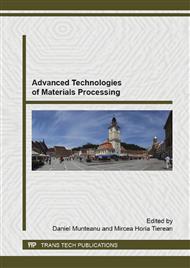[1]
C.N. Elias, J.H.C. Lima, R. Valiev, M.A. Meyers, Biomedical applications of titanium and its alloys, Biological Materials Science 2 (2008) 46-49.
Google Scholar
[2]
C. Oldani, A. Dominguez, Titanium as a Biomaterial for Implants, Recent Advances in Arthroplasty, InTech Open, Skopje, (2012).
DOI: 10.5772/27413
Google Scholar
[3]
Y. Li, C. Yang, H. Zhao, S. Qu, X. Li, Y. Li, New Developments of Ti-Based Alloys for Biomedical Applications, Materials 3 (2014) 1709-1800.
DOI: 10.3390/ma7031709
Google Scholar
[4]
M. Niinomi, Low Modulus Titanium Alloys for Inhibiting Atrophy, InTech Open, Skopje, 249-268.
Google Scholar
[5]
B. Ghiban, Metallic Biomaterials, Printech, Bucuresti, (1999).
Google Scholar
[6]
S.M. Dudescu, D.C. Bratu, R.V. Pop, M. Petrisor, M. Pacurar, Influence of the chemical compotion on the mechanical properties of orthodontic archwires, Revista de Chimie (Bucharest) 64 (2013) 771-775.
Google Scholar
[7]
D. Bombac, M. Brojan, P. Fajfar, F. Kosel, R. Turk, Review of materials in medical applications, Materials and Geoenvironment 54 (2007) 471-499.
Google Scholar
[8]
Information on http: /www. straumann. implantdivision. ro.
Google Scholar
[9]
Information on http: /imgarcade. com/1/titanium-joint-replacement.
Google Scholar
[10]
Information on http: /www. orthopaedic-implants. com/ (20. 01. 2015).
Google Scholar
[11]
Informationonhttp: /www. medicalexpo. com/manufacturer/aortic-valve-prosthesis-4609. html.
Google Scholar
[12]
J.R. Davis, Handbook of materials for medical devices, ASM International, New York, (2003).
Google Scholar
[13]
Information on http: /www. synthes. com.
Google Scholar
[14]
M.G. Minciuna, P. Vizureanu, D.C. Achitei, N. Ghiban, A.C. Sandu, N.C. Forna, Structural Characterization of Some CoCrMo Alloys with Medical Applications, Revista de Chimie (Bucharest) 65 (2014) 335-338.
Google Scholar
[15]
M. Long, H.J. Rack, Titanium alloys in total joint replacement-A materials science perspective. Biomaterials 19 (1998) 1621–1639.
DOI: 10.1016/s0142-9612(97)00146-4
Google Scholar
[16]
K. Wang, The use of titanium for medical applications in the USA, Materials Science and Engineering A 223 (1996) 134-137.
Google Scholar
[17]
R. Chelariu, L.G. Bujoreanu, C. Roman, Materiale metalice biocompatibile cu baza titan, Politehnium, Iaşi, (2006).
Google Scholar
[18]
M. Geetha, A.K. Singh, R. Asokamani, A.K. Gogia, Ti based biomaterials, the ultimate choice for orthopaedic implants - A review, Materials Science 54 (2009) 397-425.
DOI: 10.1016/j.pmatsci.2008.06.004
Google Scholar
[19]
G. Ciobanu, G. Carja, O. Ciobanu, I. Sandu, A. Sandu, SEM and EDX studies of bioactive hydroxyapatite coatings on titanium implants, Micron 40 (2009) 143-146.
DOI: 10.1016/j.micron.2007.11.011
Google Scholar
[20]
Information on http: /www. uobabylon. edu. iq.
Google Scholar
[21]
N.R. Patel, P. P. Gohil, A review on Biomaterials: Scope, Applications & Human Anatomy Significance, Biomaterials 2 (2012) 91-101.
Google Scholar
[22]
B. Boyer, G. Welsch, E.W. Collings, Materials Properties Handbook: Titanium Alloys; ASM International: Materials Park, Ohio, (2007).
Google Scholar
[23]
M. Niinomi, Mechanical properties of biomedical titanium alloys, Materials Science and Engineering A 243 (1998) 231-236.
DOI: 10.1016/s0921-5093(97)00806-x
Google Scholar
[24]
Y. Zhan, C. Li, W. Jiang, β-type Ti-10Mo-1. 25Si-xZr biomaterials for applications in hard tissue replacements, Materials Science and Engineering C 32 (2012) 1664–1668.
DOI: 10.1016/j.msec.2012.04.059
Google Scholar
[25]
L.J. Xu, Y.Y. Chen, Z.G. Liu, F.T. Kong, The microstructure and properties of Ti-Mo-Nb alloys for biomedical application, Journal of Alloys and Compounds 453 (2008) 320-324.
DOI: 10.1016/j.jallcom.2006.11.144
Google Scholar
[26]
C. Li, Y. Zhan, W. Jiang, β-Type Ti-Mo-Si ternary alloys designed for biomedical applications, Materials and Design 2 (2012) 479-482.
DOI: 10.1016/j.matdes.2011.08.012
Google Scholar
[27]
D.F. Williams, Definitions in Biomaterials, Proceedings of a Consensus Conference of the European Society for Biomaterials 4 (1986) 55-66.
Google Scholar
[28]
S.G. Steinemann, Titanium-the material of choice?, Periodontology 17 (2000) 7–21.
Google Scholar
[29]
M. Calin, A. Gebert, A.C. Ghinea, P.F. Gostin, S. Abdi, C.H. Mickel, J. Eckert, Designing biocompatible Ti-based metallic glasses for implant applications, Materials Science and Engineering C 33 (2013) 875–883.
DOI: 10.1016/j.msec.2012.11.015
Google Scholar
[30]
Q. Chen, A. George, Metallic implant biomaterials, Materials Science and Engineering R. 87 (2015) 1–57.
Google Scholar
[31]
S. Tamilselvi, V. Raman, N. Rajendran, Corrosion behaviour of Ti–6Al–7Nb and Ti–6Al–4V ELI alloys in the simulated body fluid solution by electrochemical impedance spectroscopy, Electrochim Acta 52 (2006) 839-846.
DOI: 10.1016/j.electacta.2006.06.018
Google Scholar
[32]
N.T.C. Oliveira, A.C. Guastaldi, Electrochemical stability and corrosion resistance of Ti–Mo alloys for biomedical applications, Acta Biomaterialia 5 (2009) 399-405.
DOI: 10.1016/j.actbio.2008.07.010
Google Scholar
[33]
M. Geetha, U.K. Mudali, A.K. Gogia, R. Asokamani, R. Baldev, Influence of microstructure and alloying elements on corrosion behavior of Ti–13Nb–13Zr alloy, Corrosion Science 46 (2004) 877-892.
DOI: 10.1016/s0010-938x(03)00186-0
Google Scholar
[34]
M.G. Minciuna, P. Vizureanu, D.C. Achitei, B. Ghiban, A.C. Sandu, D. Mareci, A. Balan, Electrochemical Behaviour of CoCrMo and CoCrMoSi5 alloys at Different Simulated Psysiological Medium, Revista de Chimie (Bucharest) 65 (2014) 1138-1141.
Google Scholar


